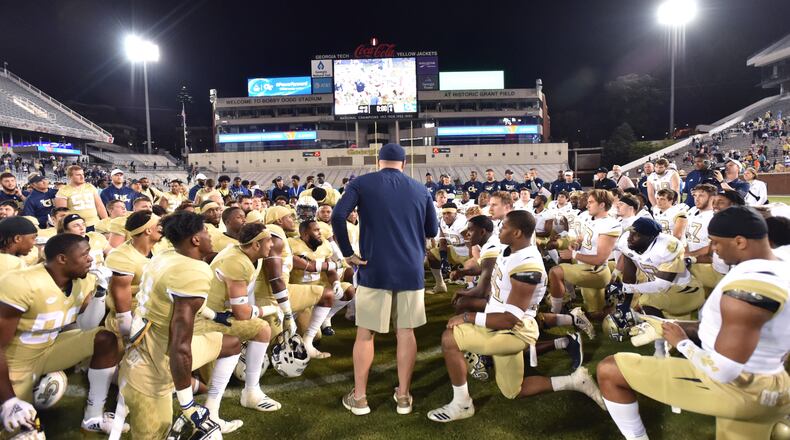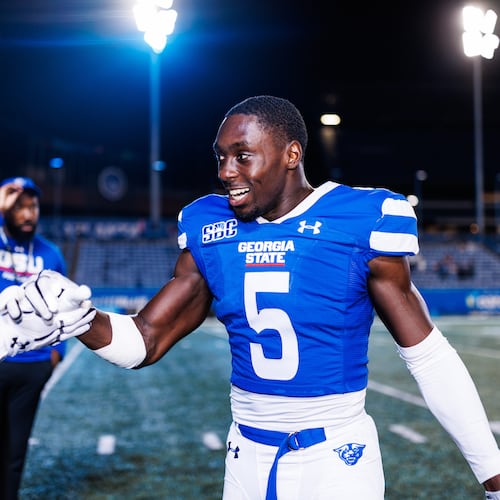Georgia Tech’s coaching staff hit the road in earnest Monday, fanning across the state and country in search of recruits. After the end of spring practice Friday, Yellow Jackets coaches were scouting in south Alabama (safeties coach Nathan Burton), North Carolina (wide receivers coach Kerry Dixon) and Pennsylvania (offensive coordinator Dave Patenaude) and dotted around the state.
They can be on the road through the month of May, visiting with high-school coaches, watching spring practice and gathering information critical for the recruiting classes of 2020, 2021 and beyond. Meanwhile, though, other members of coach Geoff Collins’ staff will be bunkered with an objective to be met far sooner – poring through the hours of video from spring practice and gleaning observations that can aid the Jackets in the coming season.
Collins delved into it Friday night after the spring game, specifically noting how it could help quarterbacks Lucas Johnson, James Graham and Tobias Oliver.
“All the quality-control (specialists), all the (graduate assistants), all the analysts for the next four weeks, while our full-time coaches are out on the road recruiting, they will dive into all of that data,” Collins said. “Here’s what we do well, here are the things that Lucas excels at, here’s the packages that he does well. Analytically, here’s what James does really well, Tobias, etc. So we can put the best packages together so that we can have success with our players.”
Collins’ emphasis on running through plays quickly at practice – Tech often had two groups going 11-on-11 at the same time – served multiple purposes. One was to maximize opportunities for players to prove themselves. Another was to run through as many different schemes and packages as many times as possible and accumulate data. The repetition helped players learn, but also gave coaches material to examine later.
“So we went very high volume,” defensive coordinator Andrew Thacker said. “That was at times at the cost of execution, but it was critical for us to get things on tape to get those concepts learned.”
The review will fall to the likes of quality-control specialists Will Glover and Jason Semore, analyst Joe Battaglia and graduate assistants Errin Joe, Trey Money, Nick Newsome and Tyson Wachenheim and football research and analytics coordinator Pat Boyle. (By NCAA rules, only the head coach and assistant coaches are permitted to go on the road to recruit.)
They will have plenty of video to inspect and sort, trying to determine what personnel groupings, formations and plays worked best (and worst) in the spring.
“There’s some periods, we’ll go to a team blitz period, and there’ll be a 24-play rack of plays, and James and Lucas won’t see the same blitz twice in a 24-play rack,” Collins said. “So the big thing we’ve tried to do is expose them to all the schemes that we have over 15 practices, then figure out what they do well and what they’re built to do based on personnel and now we’ll refine after we watch the cut-ups and do the self-scout from the spring.”
The first two series alone for the Gold-team offense (first string) in Friday’s spring game indicated the potential volume of data to analyze.
In 22 plays on those two possessions, tight ends were used as H-backs, flexed out as receivers and on the line in a three-point stance. Running backs lined up even with Johnson (in the shotgun) to his left or right, slightly behind to his left or right, two yards behind in a pistol set or in a two-back formation flanking Johnson.
In one-back sets, sometimes the back was on the tight end’s side, other times on the opposite side. At least twice, Tech lined up with three receivers to either side of the ball in a trips formation. In 22 plays, there were at least a dozen different formations.
“I still feel like there’s a lot of stuff we need to improve on, and we have all summer to work out the kinks, and when we come back in camp, we’re going to start the install right over,” Johnson said. “So I feel like everybody’ll come back a lot more comfortable with knowing everything they need to do.”
It’s possible staff could do a deeper dive on the cornerbacks, where Tre Swilling emerged in the spring, but the other spot has been “kind of trial by fire a little bit,” Thacker said, as Jaylon King, early-enrollee Jordan Huff and Zamari Walton are coming the competitors.
Reviewing what roles best fit early-enrollee freshman wide receiver Ahmarean Brown could be another task. Brown was impressive both for his quickness, but also his understanding of the offense. In the spring game, he distinguished himself not only with a four-yard catch for a touchdown, but also by being a willing and able blocker, not something that would be expected of a freshman who checks in at 5-foot-10 and 165 pounds.
“He’s out there running with the (first group),” offensive coordinator Dave Patenaude said. “Really, really fast.”
On the surface, May begins a period of dormancy in college football, as spring practice ends and the wait for preseason practice begins. Beneath the surface, though, the grunt work continues on.
About the Author
Keep Reading
The Latest
Featured


